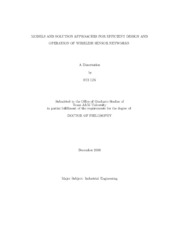| dc.description.abstract | Recent advancements in sensory devices are presenting various opportunities for
widespread applications of wireless sensor networks (WSNs). The most distinguishing
characteristic of a WSN is the fact that its sensors have nite and non-renewable
energy resources. Many research e orts aim at developing energy e cient network
topology and routing schemes for prolonging the network lifetime. However, we notice
that, in the majority of the literature, topology control and routing problems are
handled separately, thus overlooking the interrelationships among them.
In this dissertation, we consider an integrated topology control and routing problem
in WSNs which are unique type of data gathering networks characterized by limited
energy resources at the sensor nodes distributed over the network. We suggest an
underlying hierarchical topology and routing structure that aims to achieve the most
prolonged network lifetime via e cient use of limited energy resources and addressing
operational speci cities of WSNs such as communication-computation trade-o , data
aggregation, and multi-hop data transfer for better energy e ciency. We develop and
examine three di erent objectives and their associated mathematical models that de-
ne alternative policies to be employed in each period of a deployment cycle for the
purpose of maximizing the number of periods so that the network lifetime is prolonged.
On the methodology side, we develop e ective solution approaches that are based on decomposition techniques, heuristics and parallel heuristic algorithms. Furthermore,
we devise visualization tools to support our optimization e orts and demonstrate
that visualization can be very helpful in solving larger and realistic problems
with dynamic nature. This dissertation research provides novel analytical models
and solution methodologies for important practical problems in WSNs. The solution
algorithms developed herein will also contribute to the generalized mixed-discrete
optimization problem, especially for the problems with similar characteristics. | en |


